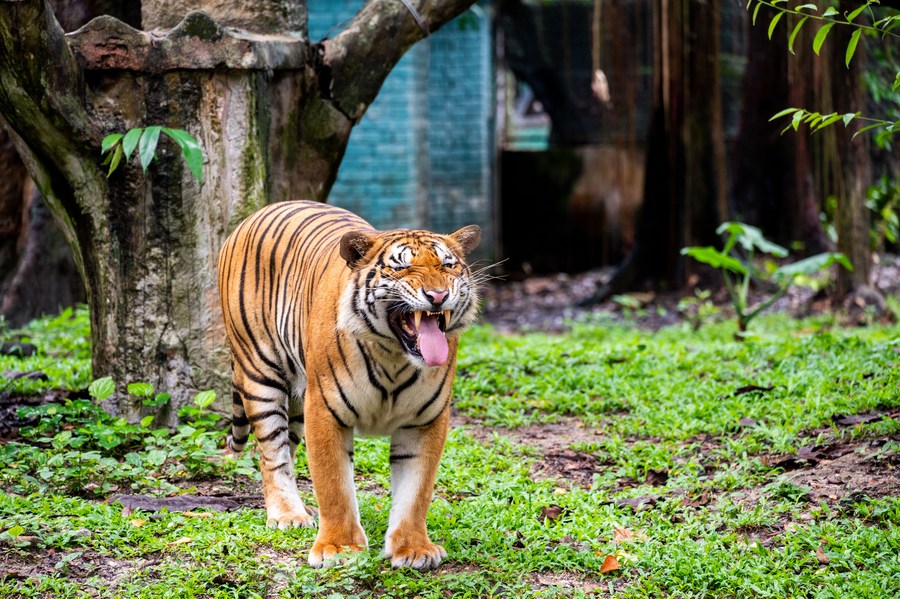Picture this: deep in Malaysia’s lush rainforests, a Malayan tiger’s amber eyes glint through the foliage, silent and majestic. I’ll never forget my first jungle trek, heart pounding as our guide whispered about a tiger spotted nearby—it was thrilling, not terrifying. Malayan tigers, one of the world’s smallest tiger subspecies, are not inherently dangerous to humans unless provoked or cornered. With only 150–300 left in the wild, per the World Wildlife Fund (WWF), these elusive cats prefer to avoid us altogether. In this article, we’ll explore why Malayan tigers pose little threat when unthreatened, the factors driving human-tiger conflicts, and how we can foster peaceful coexistence with these endangered predators.
Understanding the Malayan Tiger
The Malayan tiger, a critically endangered subspecies of Panthera tigris tigris, roams the dense forests of southern Peninsular Malaysia. Known for their smaller size—males weigh 100–140 kg—and darker, more compact stripes, they’re perfectly adapted to rainforests. Their elusive nature means human encounters are rare, with most preferring dense cover over confrontation.
A Shy and Solitary Predator
Malayan tigers are solitary, hunting deer, wild boar, and smaller mammals under the cover of night. Unlike urban-adapted leopards, they avoid human settlements unless desperate. Their natural behavior leans toward stealth, not aggression, as noted by Malaysia’s Department of Wildlife and National Parks (PERHILITAN).
Habitat and Range
Once widespread, Malayan tigers now occupy fragmented forests like Taman Negara and Endau-Rompin, covering less than 5% of their historical range. Deforestation has slashed their habitat by 60% since the 1970s, forcing some closer to human areas, per WWF data.
- Key Traits: Smaller size, dark orange coat, nocturnal habits.
- Diet: Sambar deer, barking deer, wild boar.
- Range: Taman Negara, Belum-Temengor, southern Peninsular Malaysia.
| Attribute | Malayan Tiger | Comparison (Bengal Tiger) |
|---|---|---|
| Weight | 100–140 kg (males) | 180–260 kg (males) |
| Habitat | Dense rainforests | Forests, grasslands, mangroves |
| Population | 150–300 | 2,500–3,500 |
Why Malayan Tigers Avoid Humans
Malayan tigers are not natural man-eaters. Studies by PERHILITAN show fewer than 10 human-tiger conflicts annually, with most incidents linked to habitat encroachment or poaching. Their instinct is to flee, not fight, unless threatened or protecting cubs. Understanding this behavior is key to coexistence.
Natural Instincts Favor Avoidance
Tigers rely on stealth to hunt, and humans aren’t on their menu. Camera traps in Taman Negara reveal tigers skirting villages, even when prey is scarce. A 2023 study by Panthera found no unprovoked attacks in areas with intact forests.
When Tigers Feel Threatened
Conflicts arise when tigers are cornered, injured, or protecting cubs. In 2022, a villager in Pahang startled a tigress with cubs, prompting a defensive reaction. Such incidents are rare but highlight the need for safe distances and undisturbed habitats.
Featured Snippet Opportunity: Are Malayan tigers dangerous to humans? Malayan tigers are not a threat unless provoked, cornered, or protecting cubs. They prefer to avoid humans, with fewer than 10 conflicts annually, per PERHILITAN data.
Factors Driving Human-Tiger Conflict
While Malayan tigers avoid humans, habitat loss, prey depletion, and human encroachment push them into conflict. Since 2000, Malaysia’s forests have shrunk by 20%, per Global Forest Watch, forcing tigers into human-dominated areas. Addressing these root causes is critical for safety.
Habitat Loss and Fragmentation
Deforestation for palm oil and urban development has fragmented tiger habitats. In Kelantan, forest cover dropped from 60% in 1990 to 40% by 2020, pushing tigers toward villages. Fragmented corridors prevent safe movement, increasing encounters.
Prey Depletion
Overhunting of deer and boar reduces tiger food sources. A 2021 Panthera study found 30% fewer prey animals in degraded forests, driving tigers to livestock, which sparks conflict. Restoring prey populations is essential to keep tigers in the wild.
Human Encroachment
Villages expanding into forest edges, like near Endau-Rompin, bring humans closer to tiger territories. Poaching, though rare, also provokes defensive behavior. Education and boundary enforcement can minimize these risks.
- Main Threats: Deforestation, prey loss, human expansion.
- Conflict Triggers: Livestock predation, accidental encounters, poaching.
- Solutions: Habitat restoration, prey recovery, community education.
Pros of Addressing Conflict:
- Reduces human-tiger incidents
- Protects tiger populations
- Supports rural safety
Cons:
- High conservation costs
- Slow habitat recovery
- Resistance from local industries
Conservation Efforts to Protect Malayan Tigers
Malaysia’s conservation initiatives have made strides in protecting Malayan tigers. Programs like MYCAT (Malaysia Conservation Alliance for Tigers) and PERHILITAN’s National Tiger Conservation Action Plan aim to double the population to 1,000 by 2030. These efforts reduce threats, keeping tigers non-aggressive.
Habitat Protection and Corridors
Protected areas like Taman Negara and Royal Belum cover 10,000 km², providing safe havens. Wildlife corridors, like the Central Forest Spine, connect fragmented habitats, allowing tigers to roam without nearing villages. WWF reports a 15% increase in corridor connectivity since 2015.
Anti-Poaching Measures
PERHILITAN’s ranger patrols and camera traps deter poaching, with 20 poachers arrested in 2023. Drones and AI monitoring, tested in Belum-Temengor, enhance detection. These measures keep tigers secure, reducing defensive encounters.
Community-Based Conservation
MYCAT’s Citizen Action for Tigers engages locals in monitoring and education. In Terengganu, villagers report sightings via WhatsApp, helping rangers relocate tigers safely. Such programs reduce fear and foster coexistence.
| Initiative | Impact | Key Player |
|---|---|---|
| Wildlife Corridors | Improved tiger movement | WWF, PERHILITAN |
| Anti-Poaching Patrols | Reduced illegal hunting | PERHILITAN |
| Community Education | Lower conflict rates | MYCAT |
Coexisting with Malayan Tigers
Coexistence is possible when humans respect tiger boundaries. In areas like Ulu Muda, where communities follow guidelines, conflicts dropped by 40% from 2018 to 2023, per MYCAT. Simple actions like securing livestock and avoiding night walks make a difference.
Guidelines for Safe Coexistence
Villagers near forests are advised to travel in groups, avoid dusk-to-dawn walks, and use predator-proof pens. PERHILITAN’s 2022 campaign taught 5,000 residents these practices, cutting livestock losses by 25% in Pahang.
Community Success Stories
In Kampung Ulu Tembeling, locals work with MYCAT to monitor tigers, reporting sightings via apps. This collaboration has kept conflicts near zero since 2020, showing how education empowers communities to live alongside tigers.
- Key Practices: Group travel, secure livestock, early reporting.
- Tools: MYCAT’s monitoring app, predator-proof pens, community workshops.
- Resources: PERHILITAN guidelines, WWF education programs.
Comparison: Conflict vs. Coexistence Areas
- Conflict Areas: High deforestation, no education, frequent livestock loss.
- Coexistence Areas: Intact forests, community training, minimal incidents.
Visiting Malayan Tiger Habitats
Visiting tiger habitats like Taman Negara offers a chance to witness these cats while supporting conservation. Guided tours through operators like Naturetrek ensure ethical viewing, with park fees funding protection. It’s a rare chance to see a Malayan tiger in its element.
Top Destinations for Tiger Spotting
Taman Negara, Malaysia’s largest national park, hosts 50–70 tigers, with guided night treks offering sightings. Endau-Rompin and Belum-Temengor are also prime spots, with trails designed for minimal disturbance.
Ethical Wildlife Tourism
Choose operators like Responsible Travel, which prioritize low-impact tours. Avoid feeding or baiting, banned by PERHILITAN, to keep tigers wild. Tours cost $2,000–$4,000 for 10–14 days, per TourRadar reviews.
Best Tools for Tiger Watching
Use binoculars like Nikon Prostaff for safe spotting and apps like iNaturalist to log sightings, aiding research. Local guides, trained by MYCAT, enhance your experience with expert knowledge.
- Destinations: Taman Negara, Endau-Rompin, Belum-Temengor.
- Essentials: Binoculars, sturdy boots, insect repellent.
- Operators: Naturetrek, Responsible Travel, Wild Malaysia.
Featured Snippet Opportunity: Where can I see Malayan tigers? Visit Taman Negara, Endau-Rompin, or Belum-Temengor national parks for ethical tiger spotting. Guided tours with operators like Responsible Travel ensure safe, low-impact experiences.
How You Can Support Malayan Tiger Conservation
Your actions, from donations to sustainable choices, can protect Malayan tigers. Supporting NGOs like WWF or MYCAT funds patrols and education, while eco-friendly products reduce habitat pressure. Every step helps keep tigers non-threatening.
Practical Ways to Help
Donate to WWF’s tiger programs or join MYCAT’s volunteer patrols. Buy FSC-certified products to support sustainable forestry, preserving tiger habitats. Share conservation posts on social media to raise awareness.
Tools for Conservation
Apps like MYCAT’s monitoring platform let you report sightings, while platforms like GlobalGiving connect you to tiger projects. Eco-friendly brands like Rainforest Alliance-certified products support sustainable agriculture.
- Donate: WWF, MYCAT, Panthera.
- Act: Use sustainable products, join citizen science.
- Share: Amplify campaigns like #SaveOurTigers.
People Also Ask (PAA)
Are Malayan tigers dangerous to humans?
Malayan tigers rarely attack unless threatened, cornered, or protecting cubs. PERHILITAN reports fewer than 10 conflicts annually, mostly linked to habitat loss.
Why are Malayan tigers endangered?
Habitat loss from deforestation, prey depletion, and poaching threaten Malayan tigers. Only 150–300 remain, with 60% habitat loss since the 1970s, per WWF.
Where can I see Malayan tigers in the wild?
Taman Negara, Endau-Rompin, and Belum-Temengor offer the best chances. Book ethical tours with operators like Naturetrek for guided, low-impact experiences.
How can I help Malayan tiger conservation?
Donate to WWF or MYCAT, use sustainable products, and join citizen science via apps like iNaturalist. Supporting ethical tourism also funds conservation.
What causes human-tiger conflicts in Malaysia?
Deforestation, prey scarcity, and human encroachment drive conflicts. Education and habitat restoration, like MYCAT’s programs, reduce incidents by 40% in some areas.
FAQ Section
What is a Malayan tiger?
The Malayan tiger is a critically endangered subspecies in Peninsular Malaysia, smaller than other tigers, with 150–300 left in rainforests like Taman Negara.
Why don’t Malayan tigers attack humans?
Their shy, nocturnal nature leads them to avoid humans. Conflicts occur only when provoked, with fewer than 10 incidents yearly, per PERHILITAN.
How can communities coexist with Malayan tigers?
Using predator-proof pens, traveling in groups, and reporting sightings to MYCAT or PERHILITAN minimizes conflicts and fosters safe coexistence.
What are the best tools for tiger conservation?
Apps like iNaturalist, binoculars for spotting, and donations via GlobalGiving support conservation. Ethical tour operators like Responsible Travel fund protection.
How does tourism help Malayan tigers?
Ethical tourism funds park maintenance and ranger patrols. Fees from Taman Negara visits, for example, support WWF’s habitat restoration projects.
Conclusion: Living in Harmony with Malayan Tigers
Malayan tigers aren’t the villains of horror stories—they’re shy giants who’d rather slip away than confront us. I still feel a shiver thinking of that jungle trek, knowing a tiger was out there, living its quiet life. By protecting their forests, supporting prey recovery, and choosing ethical tourism, we can keep these cats non-threatening. Visit Taman Negara through operators like Responsible Travel or donate to WWF and MYCAT. Together, we can ensure Malayan tigers roam free, safe from threats—and safe for us.





